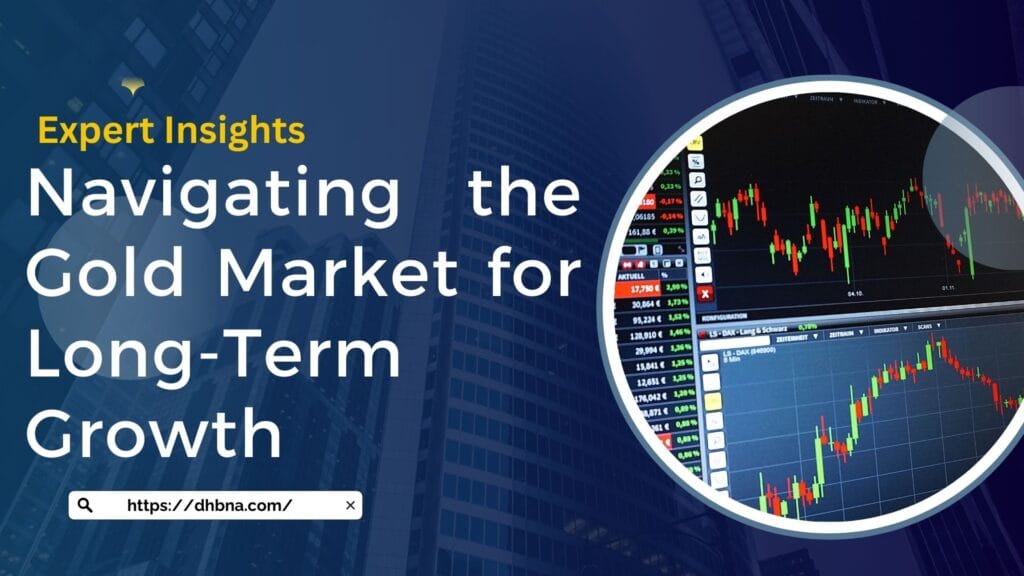Gold remains one of the most sought-after assets for investors seeking long-term financial security. In today’s complex economic landscape, understanding how to navigate the gold market is crucial for achieving sustained growth. In this article, we provide expert insights on navigating the gold market for long-term growth, outlining key strategies, market drivers, and practical tips that help investors make informed decisions. Whether you’re a seasoned investor or just beginning your journey, these insights will guide you in harnessing gold’s potential for enduring prosperity.
Introduction
Throughout history, gold has been revered as a symbol of wealth and a safeguard against economic uncertainties. Today, despite the advent of modern financial instruments, gold continues to be a reliable store of value and a cornerstone of diversified investment portfolios. Expert insights: Navigating the gold market for long-term growth are more relevant now than ever as investors face global economic turbulence, currency fluctuations, and geopolitical tensions.
This comprehensive guide will delve into the multifaceted benefits of gold investing, address the inherent risks, and provide actionable strategies for maintaining long-term growth. We’ll explore how macroeconomic trends, technical analysis, and expert recommendations converge to create a roadmap for navigating the gold market successfully. Our goal is to offer rich, informative content that equips you with the knowledge you need to build a resilient investment portfolio.
Understanding the Gold Market
The Enduring Value of Gold
Gold’s appeal is not merely a product of its physical properties but also its historical and cultural significance. For centuries, gold has been recognized as a store of value, a medium of exchange, and a hedge against inflation.
Historical Stability and Trust
Gold has maintained its worth over millennia. From ancient civilizations to modern economies, gold has consistently been viewed as a secure asset. This historical stability builds trust among investors, making gold an essential component of any long-term investment strategy.
Gold as a Hedge Against Economic Uncertainty
In times of financial instability—such as during periods of high inflation, currency devaluation, or geopolitical crises—investors often turn to gold as a safe haven. Gold’s ability to preserve purchasing power and its low correlation with other asset classes make it an attractive option for risk management.
Market Drivers Affecting Gold
Several factors influence the performance of the gold market. Expert insights into these drivers can help you make more informed investment decisions.
Economic Indicators and Monetary Policies
Economic data such as inflation rates, employment figures, and GDP growth are critical in shaping gold’s price. Lower interest rates, often a result of dovish monetary policies, tend to weaken fiat currencies, thereby enhancing gold’s appeal as a non-yielding asset. Central banks’ policies play a significant role; when central banks adopt accommodative measures to stimulate growth, gold often benefits as investors seek alternatives to traditional currency investments.
Geopolitical Tensions and Global Uncertainty
Geopolitical events—ranging from trade disputes to conflicts in volatile regions—frequently drive investors toward gold. This demand surge is fueled by gold’s reputation as a stable asset during uncertain times. In today’s environment, where global tensions remain high, expert insights suggest that gold’s role as a safe haven will continue to be a key factor in its long-term growth.
Supply and Demand Dynamics
The physical supply of gold is relatively fixed, with mining output growing slowly compared to other commodities. At the same time, demand for gold comes from various sectors, including jewelry, technology, and institutional investments. This delicate balance between supply and demand reinforces gold’s long-term value and influences its market price.
Strategies for Navigating the Gold Market
Long-Term Investment Strategies
For investors with a long-term horizon, gold offers numerous benefits that can help secure financial stability and growth.
Diversification and Risk Management
Diversifying your investment portfolio by including gold can help reduce overall risk. Since gold often moves independently of stocks and bonds, it serves as an effective hedge against market volatility. Experts recommend allocating between 5% to 15% of your portfolio to gold to achieve a balanced asset distribution.
Dollar-Cost Averaging
Implementing a dollar-cost averaging strategy—where you invest a fixed amount in gold at regular intervals—helps mitigate the impact of market volatility. Over time, this approach can lower the average cost of your investments, allowing you to benefit from long-term price appreciation.
Focus on Quality and Liquidity
When investing in gold, consider high-quality investment options such as gold bars, coins, or gold-backed ETFs. These products offer high liquidity and are easier to buy or sell as market conditions change. Prioritizing quality helps ensure that your investment retains its value and provides a stable hedge against economic uncertainties.
Short-Term Trading Strategies
For active traders, gold can also be a lucrative asset when approached with the right short-term strategies.
Technical Analysis and Market Timing
Using technical analysis tools such as moving averages, Relative Strength Index (RSI), and candlestick patterns can help identify short-term trends in the gold market. Expert insights suggest that monitoring support and resistance levels is critical; knowing when gold is approaching key thresholds can provide valuable entry and exit signals.
Scalping and Swing Trading Techniques
Scalping involves making multiple small trades to profit from minor price fluctuations, while swing trading focuses on capturing gains from medium-term trends. Both strategies require a deep understanding of technical indicators and market momentum. Active traders should use stop-loss orders and other risk management tools to protect against rapid price reversals.
Hedging and Diversification Techniques
Integrating gold into a broader investment strategy can further enhance your portfolio’s resilience.
Combining Gold with Other Safe-Haven Assets
Diversification is key to managing risk. By pairing gold with other safe-haven assets such as silver or platinum, you can create a balanced portfolio that is better equipped to weather economic downturns.
Utilizing Derivatives for Hedging
For sophisticated investors, derivatives such as options and futures on gold can be valuable tools for hedging against adverse market movements. These instruments allow you to set predetermined price levels for buying or selling gold, thereby limiting potential losses during periods of high volatility.
The Benefits and Risks of Gold Investing
Benefits of Gold Investing
Gold offers a multitude of benefits that have made it a staple in investment portfolios worldwide.
Stability and Security
Gold’s long history as a stable store of value makes it a reliable asset in times of economic turmoil. Its inherent stability provides a solid foundation for long-term wealth preservation.
Inflation Protection
One of the key benefits of investing in gold is its ability to act as a hedge against inflation. When the purchasing power of fiat currencies declines, gold typically appreciates in value, thereby protecting your wealth.
Liquidity and Global Acceptance
Gold’s high liquidity ensures that it can be easily bought or sold without significantly impacting its price. Its global recognition makes it a universally accepted asset, providing investors with confidence in its long-term viability.
Risks of Gold Investing
Despite its many advantages, gold investing also carries certain risks that investors must consider.
Market Volatility
Although gold is generally stable, it can experience significant short-term price fluctuations due to market sentiment and speculative trading. This volatility may result in temporary losses for investors who time the market poorly.
Storage and Transaction Costs
Investing in physical gold involves additional costs such as secure storage and insurance. Moreover, transaction fees and premiums can reduce overall returns, making it important to weigh these expenses against potential gains.
Regulatory and Geopolitical Risks
Changes in government policies, taxation, and international regulations can impact the gold market. Additionally, geopolitical events, while often supporting gold’s role as a safe haven, can also create periods of uncertainty that may affect its price adversely.
Expert Insights: Navigating the Gold Market for Long-Term Growth
Why Expert Insights Matter
Expert insights provide a critical edge in navigating the complex dynamics of the gold market. Experienced analysts draw on a wealth of data, historical trends, and technical analysis to offer informed perspectives that can guide your investment decisions. By integrating expert opinions into your strategy, you can better anticipate market movements and adjust your portfolio accordingly.
Learning from Historical Trends
Experts emphasize that gold’s historical performance offers valuable lessons. Despite short-term volatility, gold has consistently proven its ability to preserve value over centuries. This long-term stability underpins many expert recommendations for incorporating gold into diversified portfolios.
The Role of Central Banks
Analysts also point out that the actions of central banks play a significant role in shaping the gold market. When central banks increase their gold reserves or maintain low interest rates, these policies tend to support gold’s price. Expert insights on central bank behavior can help investors forecast potential market shifts and plan their investments for long-term growth.
Future Outlook and Strategic Recommendations
Based on current market conditions and expert insights, the future outlook for gold remains promising. While short-term volatility is inevitable, the long-term trends indicate that gold will continue to be a vital asset for portfolio diversification and wealth preservation.
Strategic Recommendations for Long-Term Investors
- Diversification:
Allocate a balanced portion of your portfolio to gold to reduce overall risk. - Regular Investment:
Employ dollar-cost averaging to mitigate the effects of market volatility. - Focus on Quality:
Invest in high-quality gold products, whether physical or through reliable ETFs, to ensure long-term stability.
Strategic Recommendations for Short-Term Traders
- Monitor Technical Signals:
Use technical indicators such as RSI and moving averages to guide your trading decisions. - Active Trading:
Consider scalping or swing trading strategies to take advantage of short-term price movements. - Risk Management:
Implement stop-loss orders and other risk management tools to protect your investments during volatile periods.
Conclusion: Maximizing Your Portfolio’s Potential with Gold Investing
In the realm of investing, gold has earned its reputation as a timeless asset that provides both stability and growth potential. The expert insights presented in this guide on exploring the benefits and risks of gold investing underscore the importance of a balanced approach that leverages gold’s unique characteristics while mitigating its inherent risks.
By adopting a diversified strategy that includes both long-term accumulation and tactical short-term trading, investors can harness the full potential of gold. Whether you are looking to safeguard your wealth against inflation, reduce portfolio volatility, or seize short-term trading opportunities, a well-planned gold investment strategy can help secure your financial future.
Invest wisely, stay informed, and continually refine your approach based on evolving market conditions. With its enduring value, high liquidity, and global acceptance, gold remains a cornerstone of any robust investment portfolio—a timeless asset that will continue to shine, even in the most turbulent economic environments.
Thank you for reading our comprehensive guide on “Exploring the Benefits and Risks of Gold Investing.” We hope this article has provided you with valuable insights and practical strategies to help you navigate the gold market for long-term growth. Happy investing, and may your financial future be as brilliant as the enduring allure of gold!
Discover more from Dhbna
Subscribe to get the latest posts sent to your email.



